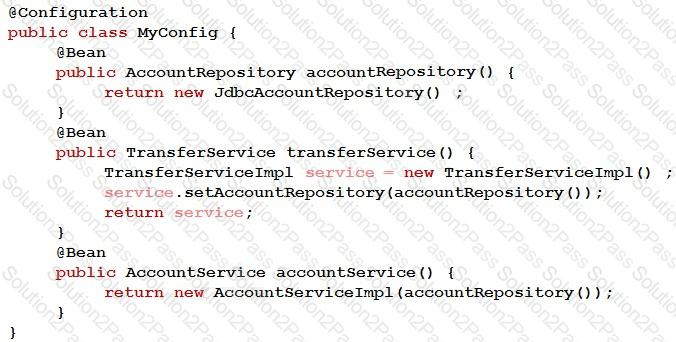2V0-72.22 VMware Professional Develop VMware Spring Free Practice Exam Questions (2025 Updated)
Prepare effectively for your VMware 2V0-72.22 Professional Develop VMware Spring certification with our extensive collection of free, high-quality practice questions. Each question is designed to mirror the actual exam format and objectives, complete with comprehensive answers and detailed explanations. Our materials are regularly updated for 2025, ensuring you have the most current resources to build confidence and succeed on your first attempt.
Which statement is true? (Choose the best answer.)
Refer to the exhibit.

Based on the default Spring behavior, choose the correct answer. (Choose the best answer.)
If a class is annotated with @Component, what should be done to have Spring automatically detect the annotated class and load it as a bean? (Choose the best answer.)
Spring puts each bean instance in a scope. What is the default scope? (Choose the best answer.)
Refer to the exhibit.

Which option is a valid way to retrieve the account id? (Choose the best answer.)
Which two statements are true regarding Spring Security? (Choose two.)
Which two annotations indicate that the transaction for a transactional test method should be committed after the test method has completed? (Choose two.)
Which two annotations are meta-annotations on the @SpringBootApplication composed annotation? (Choose two.)
Which two use cases can be addressed by the method level security annotation @PreAuthorize? (Choose two.)
Refer to the exhibit.
It is a Java code fragment from a Spring application. Which statement is true with regard to the above example? (Choose the best answer.)
Which two statements are correct when @SpringBootApplication is annotated on a class? (Choose two.)
Which two statements are true regarding a Spring Boot "fat" JAR? (Choose two.)
What are the two reasons Spring be used to build a Java application? (Choose two.)
Which statement about @TestPropertySource annotation is true? (Choose the best answer.)
Refer to the exhibit.

Assume that the application is using Spring transaction management which uses Spring AOP internally.
Choose the statement that describes what is happening when the update1 method is called? (Choose the best answer.)
Which two statements are correct regarding the Actuator info endpoint? (Choose two.)
Which two statements are true regarding bean creation? (Choose two.)
Which strategy is correct for configuring Spring Security to intercept particular URLs? (Choose the best answer.)
Which two statements are true about REST? (Choose two.)
Which three statements are advantages of using Spring’s Dependency Injection? (Choose three.)
